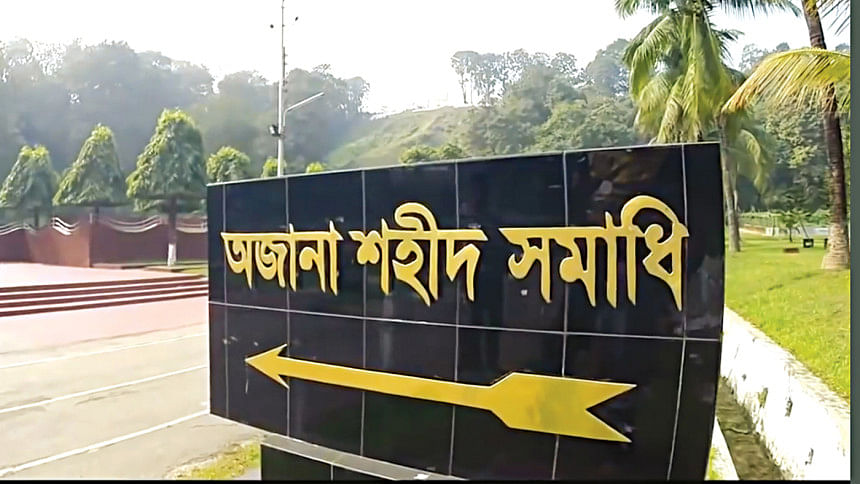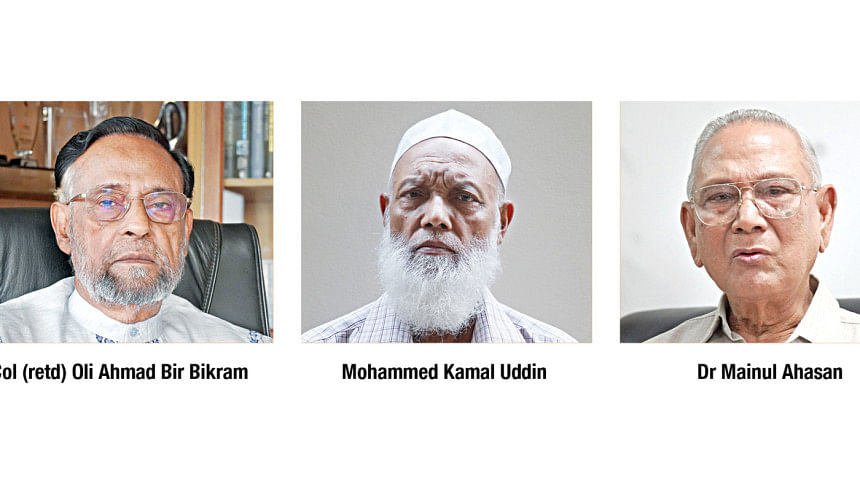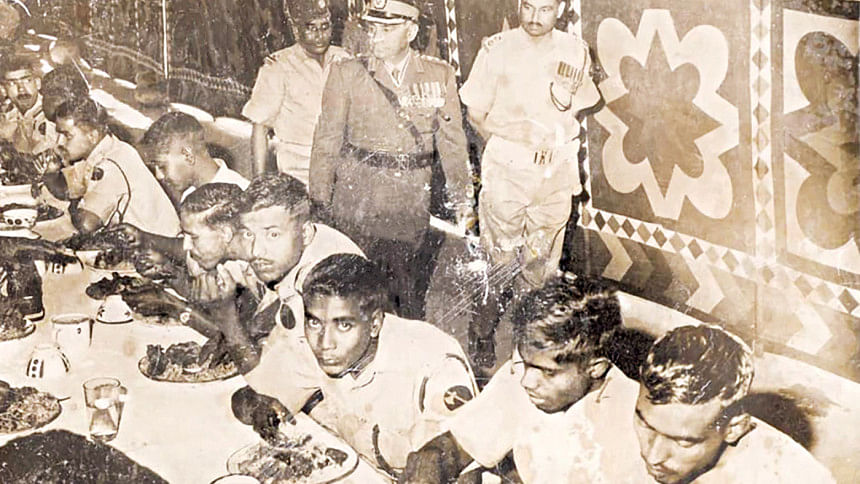Operation searchlight: The massacre at Ctg cantonment

On March 24, 1971, the day before the Pakistani army unleashed the infamous "Operation Searchlight," its top brass flew to Chattogram Cantonment from Dhaka.
By then, a quiet but growing spirit of rebellion was taking shape among the Bangalee soldiers stationed at the East Bengal Regimental Centre (EBRC), an infantry training facility in the port city.
The delegation included high-ranking figures such as Chief of Army Staff Gen Hamid Khan, Maj Gen Khadim Hussain Raja, Maj Gen Mitha Khan, and Brig Ansari. These officials convened secret meetings, deliberately excluding EBRC Commandant Brig Mahmudur Rahman Majumdar, the senior-most Bangalee officer there at the time, according to Bangladesher Swadhinota Juddho: Dolil Potro (Volume 9).
Earlier, Brig Majumdar had defied direct orders to unload weapons shipped from West Pakistan to Chattogram Port in late February, signalling his resistance.
The tension escalated further when the West Pakistan military leaders took Brig Majumdar back to Dhaka, pretending they needed to discuss some urgent matters with him there.
The very next night, the unthinkable tragedy unfolded.
The Pakistan army had picked the EBRC as one of the primary targets for its brutal massacre codenamed "Operation Searchlight".
On the night of March 25, 1971, the Pakistani military killed more than 1,000 Bangalee officers, soldiers, and cadets at the EBRC, writes Maj (retd) Rafiq-ul Islam, Bir Uttam, in his book "Lokkho Praner Binimoye".
In the official EBRC records, 550-600 Bangalee officers, soldiers, and cadets are listed as martyrs of that massacre.

Bangladesher Swadhinota Juddho: Dolil Potro (Volume 9), Ameen Ahmed Chowdhury's "1971 Ebong Amar Samorik Jibon", Subid Ali Bhuiyan's "Muktijuddhe Noy Mash" are some of the books that documented this carnage.
According to these books, the EBRC had over 1,500 Bangalee soldiers under training in March 1971.
Besides, the 20th Baloch Regiment, which had arrived from West Pakistan in early January 1971, was stationed there.
Lt Col Mujibur Rahman Chowdhury was the chief instructor at the EBRC.
Soon after the sunset on March 25, Pakistan forces began disarming the Bangalee soldiers.
"At 7:00pm, all of our soldiers' rifles were taken away and stored in the armoury," Subid Ali Bhuiyan, writes in his book.
Maj Mir Shawkat Ali from the 8th East Bengal Regiment was the last person to speak to anyone from the EBRC via telephone around 11:00pm -- it was Chief Instructor Lt Col Mujibur Rahman Chowdhury.

Soon after the phone call, Lt Col MR Chowdhury ordered Captain Enamul Haque to break open the armoury and distribute weapons to the Bangalee soldiers. However, before they could do so, the Baloch Regiment soldiers stormed the premises.
Captain Enamul Haque described this moment in his writings on Bangladesher Swadhinota Juddho: Dolil Potro (Volume 9).
"Suddenly, the Bangalee guard commander from that particular quarter came running and informed me that the 20th Baloch soldiers were getting off their vehicles, fully armed…Within moments, they launched an attack on the guards, and gunfire erupted from all directions."
"At 11:30pm, six truckloads of Baloch soldiers slaughtered the Bangalee troops at the armoury and surrounded the recruit barracks, where most soldiers were asleep and unarmed, leaving them no chance to resist. The Baloch troops ruthlessly gunned down every soldier in their sight," Maj (retd) Rafiq-ul Islam writes in his book "Lokkho Praner Binimoye".
Captain Enamul was captured and held in a room filled with wounded soldiers.
"I saw Bangalee soldiers in agony, some crying out for water, others writhing in pain. The Pakistani soldiers pressed their boots on the throats of the dying to hasten the process," Enamul describes his experience on Bangladesher Swadhinota Juddho: Dolil Potro (Volume 9).
In the early hours of March 26, the Baloch soldiers fired shells from tanks onto the barracks. The wounded soldiers' screams filled the cantonment. Many were executed inside the EBRC school, where Pakistani troops opened fire at point-blank range.
Captain Enamul wrote, "At 7:00am on March 26, I saw a truck being filled with the bodies of those who had been mercilessly killed overnight. More than a hundred bodies were taken away in front of my eyes."
RESISTANCE THAT NEVER CAME
Colonel Oli Ahmed, Bir Bikram, who was the quartermaster of the 8th East Bengal Regiment, later revealed that he had tried to contact Lieutenant Colonel MR Chowdhury throughout the night but failed. The next morning, he learned that MR Chowdhury had been murdered.
Asked why the 8th East Bengal Regiment did not intervene, he said, "We had limited arms and ammunition. Many of our soldiers were on leave because we were supposed to be deployed in Pakistan. The 20th Baloch Regiment was fully armed. If we had intervened, it would have been suicidal. The only chance of survival for EBRC soldiers was to escape into the hills."
The attack began with the killing of EBRC's Chief Instructor Lt Col MR Chowdhury.
His son, Colonel (retd) Mahmud Ur Rahman Chowdhury, told The Daily Star, "When my father was entering EBRC from the officers' mess, a platoon of the Baloch Regiment shot and bayoneted him to death.
"In early January 1971, MR Chowdhury, along with Brig Mahmudur Rahman Majumdar, Maj Ziaur Rahman (later president), Captain Rafiq-ul Islam, and Captain Oli Ahmed, had begun planning an armed rebellion in Chattogram. Sheikh Mujibur Rahman was aware of these plans, but since the Awami League was still pursuing a political solution, the uprising never materialised."
"If Bangabandhu supported an armed rebellion from the start, this massacre might not have happened. The war would still have taken place, but we could have avoided such massive loss of life."
IN SEARCH OF WITNESSES
Most of the Bangalee soldiers were martyred in the EBRC, but miraculously, very few survived.
The Daily Star collected names of the gallantry-awarded freedom fighters who were either serving or undergoing training at the EBRC on the night of March 25, 1971. However, none of them are now alive.
Dr Mohammad Kamal Uddin, a resident of Khondakia village (3km away from the cantonment) in Hathazari, said, "On the night of March 25, we woke up to the sound of intense gunfire. At dawn, we saw a few injured and terrified men near the Boro Dighir Paar. Their clothes were torn, and some were bleeding. They told us their weapons had been taken away earlier that evening, and they had barely escaped by crossing the hills."
At Chittagong Medical College, Dr Mainul Ahasan treated many injured soldiers on March 26.
"Most of the wounded brought in on March 26 were Bangalee soldiers from the cantonment. Many died on the way due to excessive bleeding," he told The Daily Star.

 For all latest news, follow The Daily Star's Google News channel.
For all latest news, follow The Daily Star's Google News channel. 





Comments